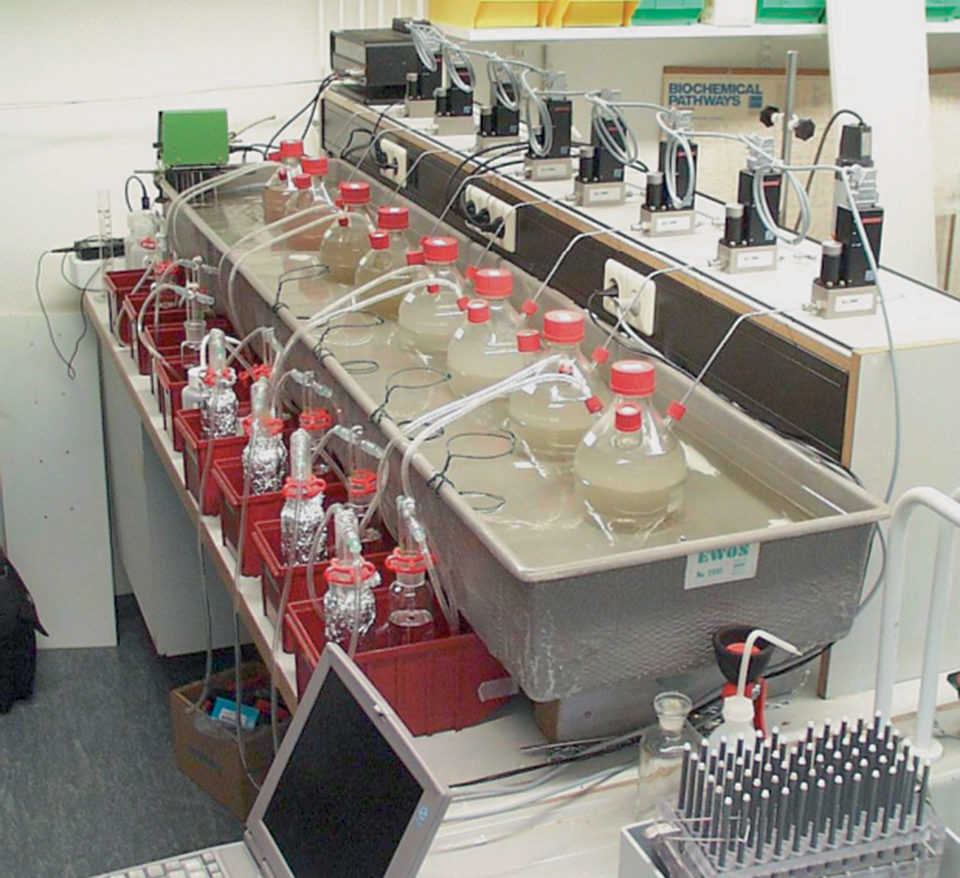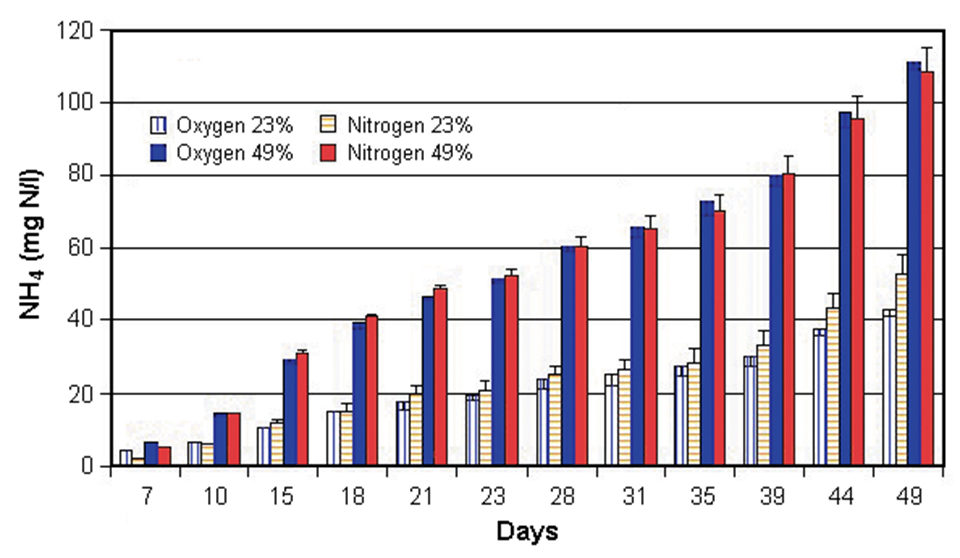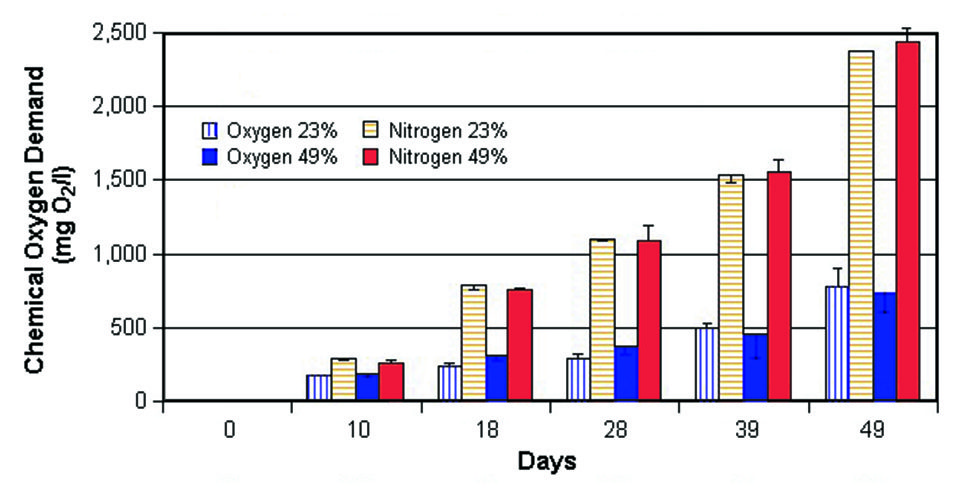Maintaining aerobic conditions provides better conditions for organic matter decomposition

In intensive and semi-intensive pond culture, the application of formulated feed constitutes the main nutrient input. Species like shrimp, salmon, and cod are fed with very high protein content of 30 to 60 percent. The use of high-protein feeds is based on assuring proper nutrition, preventing diseases, and maximizing animal growth.
Water quality is also a very important factor that influences the health and growth performance of cultured animals. It directly relates to the amount and quality of organic input that enters a pond.
A significant amount of the feed provided is typically not consumed by the targeted species and increases the organic load of the culture environment. The combination of high-protein feeds and high-intensity production, if not properly managed, can cause water quality problems.
Organic matter decomposition
The accumulation of organic matter increases as the production cycle progresses because considerable amounts of uneaten feed and excreted metabolic products and feces accumulate with dead plankton in bottom sediments. The decomposition of this organic matter consumes oxygen and can deplete the levels of dissolved oxygen in the water.
Under these conditions, anaerobic decomposition takes over. Moreover, even if there is enough dissolved oxygen in the water column above the sediment, this oxygen only penetrates a few millimeters into the very thin upper layer, while deeper stratums remain under anaerobic conditions. Therefore, the decomposition of the accumulated organic matter in aquaculture ponds occurs both in aerobic and anaerobic environments, and switches from one to the other depending on oxygen availability.
Lab study
The authors recently carried out a study to evaluate the decomposition process of fish feed with different protein content under aerobic and anaerobic conditions in an intensive fish culture setup simulated under laboratory conditions. The experiment was carried out in 2,000-ml glass flasks filled with filtered fresh water and inoculated with bacteria communities collected from a tilapia recirculation system.
The microcosm received pure oxygen or pure nitrogen. The mixture was stirred continuously and incubated in a 21 degrees-C water bath. The daily feed rate was 40 milligrams per using the two diets. Water quality parameters and organic matter decomposition indicators were routinely monitored during the 49-day experiment.
Results
Anaerobic conditions were achieved after five days, when the oxygen in the water was depleted and the average Redox potential was –399.15 ± 78.74 mV. In the aerobic flasks, the average Redox potential was 213.29 ± 39.97 mV.
The differences in the 23 and 49 percent protein input contents corresponded to 19.9 and 4.2 C:N ratio, respectively, with higher ammonia concentration in the high-protein treatment. No differences were found in oxygen presence, showing that a similar amount of nitrogen was ammonified under aerobic and anaerobic conditions (Fig. 1).

Nitrate concentrations in the anaerobic treatments were insignificant. In aerobic treatments, the average NO3– concentration was 0.87 ± 0.23 and 2.54 ± 0.33 mgN · l-1 for the 23 percent and 49 percent protein diets, respectively.
The organic matter that remained in the system was expressed through chemical oxygen demand (COD) values. The COD content increased in all treatments as the experimental period progressed (Fig. 2). The highest content of COD remaining in the anaerobic system showed that in aerobic systems, the durability of organic matter such as fish feed is short and rapidly oxidized, and leaves the system as carbon dioxide. Hydrogen sulfide, which is toxic in higher concentrations, was produced in the anaerobic treatments.

Conclusion
In this study, faster and more complete decomposition of fish feed was observed in aerobic treatments. The protein content in the fish feed influenced aerobic decomposition and nitrogen transformation pathways. A higher accumulation of nutrients in anaerobic systems was observed, compared with aerobic flasks. The ammonia nitrogen concentration in the high-protein treatment reached much higher values than in the low-protein treatment.
Maintaining aerobic conditions in an aquaculture system through mechanical aeration or water exchange provides better conditions for organic matter decomposition and complete nitrogen oxidation. Preventing anaerobic conditions is more important in intensive systems, where high organic carbon and nitrogen loads are applied. Efficient and sensible feeding regimes should be implemented for optimal aquaculture production.
(Editor’s Note: This article was originally published in the February 2004 print edition of the Global Aquaculture Advocate.)
Now that you've finished reading the article ...
… we hope you’ll consider supporting our mission to document the evolution of the global aquaculture industry and share our vast network of contributors’ expansive knowledge every week.
By becoming a Global Seafood Alliance member, you’re ensuring that all of the pre-competitive work we do through member benefits, resources and events can continue. Individual membership costs just $50 a year. GSA individual and corporate members receive complimentary access to a series of GOAL virtual events beginning in April. Join now.
Not a GSA member? Join us.
Authors
-
Beatriz Torres-Beristain
Fish Culture and Fisheries
Wageningen University
P.O. Box 338, 6700 AH
Wageningen
The Netherlands -
Marc Verdegem
Fish Culture and Fisheries
Wageningen University
P.O. Box 338, 6700 AH
Wageningen
The Netherlands -
Maciej Pilarcyk
Polish Academy of Science
Institute of Icthyobiology and Aquaculture
Poland
Related Posts

Health & Welfare
10 paths to low productivity and profitability with tilapia in sub-Saharan Africa
Tilapia culture in sub-Saharan Africa suffers from low productivity and profitability. A comprehensive management approach is needed to address the root causes.

Intelligence
A brief look at genetically modified salmon
If approved by FDA, fast-growing genetically modified salmon will provide a safe and nutritious product similar to other farmed Atlantic salmon.

Responsibility
A helping hand to lend: UK aquaculture seeks to broaden its horizons
Aquaculture is an essential contributor to the world food security challenge, and every stakeholder has a role to play in the sector’s evolution, delegates were told at the recent Aquaculture’s Global Outlook: Embracing Internationality seminar in Edinburgh, Scotland.

Health & Welfare
A holistic management approach to EMS
Early Mortality Syndrome has devastated farmed shrimp in Asia and Latin America. With better understanding of the pathogen and the development and improvement of novel strategies, shrimp farmers are now able to better manage the disease.


